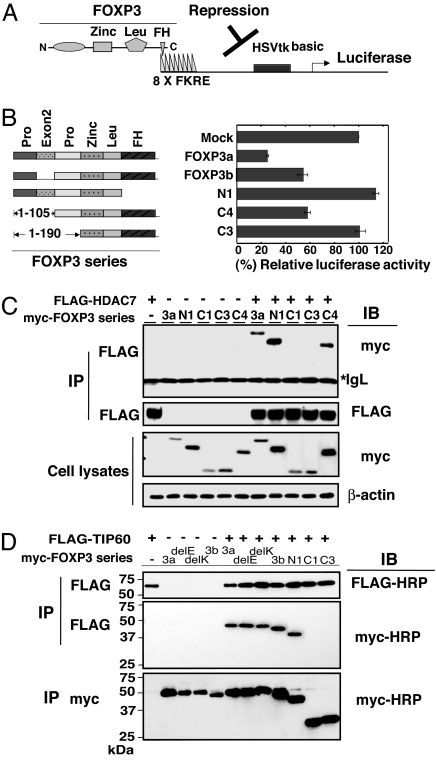Fig. 3.
N-terminal 106–190 aa as the transcriptional repression domain of FOXP3 is essential for TIP60 and HDAC7 association. (A) Schematic representation of FOXP3 binding to 8x Forkhead-binding sites luciferase reporter construct (8x FK1TK-Luc) used in luciferase reporter assay. (B) Luciferase reporter assay using 8x FK1TK-Luc reporter. 293T cells were transfected with the control empty vector (mock), wild-type FOXP3a, FOXP3b, FOXP3 forkhead domain deletion (N1) expression vectors, or FOXP3 deletion mutant del C4 or delC3, plus 8x FK1TK-Luc luciferase reporter and control TK-Renilla luciferase vector as indicated, then analyzed by means of dual luciferase assay normalized with Renilla luciferase activity. Results are means of three separate experiments with SD. (C) HDAC7 associates with 3a, N1, and C4, but not C3 with an additional deletion of 106- to 190-aa region. 293T cells were transfected with a panel of myc-tagged FOXP3 expression vectors, combined with FLAG-HDAC7 as indicated, immunoprecipitated with anti-FLAG M2, then analyzed by Western blotting with indicated Abs. (D) TIP60 associates with 3a, 3b, delE, delK, N1, but not C3 with an additional deletion of 106- to 190-aa region. 293T cells were transfected with a panel of myc-tagged FOXP3 expression vectors, with or without FLAG-TIP60 as indicated, immunoprecipitated with either anti-FLAG or anti-myc mAb, then analyzed by Western blotting with indicated Ab.

